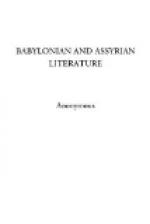And see! the vessel’s prow with shivering turns,
Adown the roaring flood that gapes and churns
Beneath like some huge boiling cauldron black,
Thus whirl they in the slimy cavern’s track.
And spirit ravens round them fill the air,
And see! they fly! the cavern sweeps behind!
Away the ship doth ride before the wind!
The darkness deep from them has fled away,
The fiends are gone!—the vessel in the
spray
With spreading sails has caught the glorious breeze,
And dances in the light o’er shining seas;
The blissful haven shines upon their way,
The waters of the Dawn sweep o’er the sea!
They proudly ride up to the glowing sand,
And joyfully the King springs to the land.
[Footnote 1: This remarkable prayer is to be found among a collection of prayers which are numbered and addressed to separate deities. It seems that the prayers were originally Accadian, and were afterward adopted by the Assyrians, and made to apply to one god (Hea). Professor Oppert and Professor Sayce think, however, that they are connected in one hymn to Hea. This may have been so after the Assyrians adopted them, but they are distinct, and addressed to separate gods. The one we have selected is addressed to Hea, the Creator of Mankind, Sayce edition Smith’s “C.A.G.,” pp. 75 to 80. The one we have selected is found at the top of page 77, idem.]
[Footnote 2: “Gibil,” the god of fire, of spells and witchcraft.]
[Footnote 3: “Nibiru,” the god of fate, and ruler of the stars.]
[Footnote 4: “Nusku,” the gatekeeper of thunders.]
[Footnote 5: “Urbat,” the dog of Death.]
[Footnote 6: “Belat” or “Allat,” the Queen of Hades.]
[Footnote 7: “Ed-hutu,” god of darkness.]
[Footnote 8: “Tsi-lat-tu,” shades of night.]
[Footnote 9: “Rimmon,” god of storms.]
[Footnote 10: “Ninip,” god of bravery and war.]
[Footnote 11: “Tablets.” This may mean charts or scrolls similar to the charts used by modern navigators. Babylon communicated with all nations in commerce.]
COLUMN III
KHASISADRA ON THE SHORE SEES THE VESSEL COMING, AND RETURNING TO HIS PALACE, SENDS HIS DAUGHTER MUA TO WELCOME IZDUBAR—MEETING OF THE KING AND SAGE
Beneath a ku-tree Khasisadra eyes
The spreading sea beneath the azure skies,
An aged youth with features grave, serene,
Matured with godly wisdom; ne’er was seen
Such majesty, nor young, nor old,—a seer
In purpose high. The countenance no fear
Of death has marred, but on his face sublime
The perfect soul has left its seal through time.
“Ah, yes! the dream was clear, the vision true,
I saw him on the ship! Is it in view?
A speck! Ah, yes! He comes! he comes to
me
My son from Erech comes across the sea!”
Back to his palace goes the holy seer,
And Mua[1] sends, who now the shore doth near;
As beautiful as Waters of the Dawn,
Comes Mua here, as graceful as a fawn.




